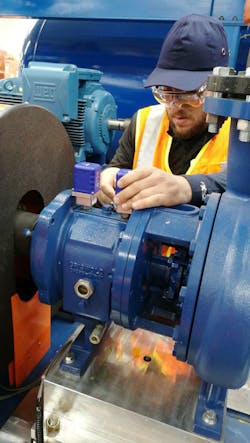Why Facility Managers Can’t Afford to be Complacent About Tech
Now that the Industrial Internet of Things (IIoT) and mobile computing are becoming commonplace in facilities, managers must stay ahead of the learning curve, replacing outmoded technology to keep pace with innovative solutions that allow for efficient operations. All facilities, regardless of type, are susceptible to system disruptions. With IIoT, facility managers have new capabilities to deal with failing systems and can modify their O&M posture altogether
Consider the existing maintenance approaches. We can all agree that reactive maintenance — responding to a malfunction only after a machine has been rendered unusable — is not the optimal practice. Preventive maintenance (PM), on the other hand, is intended to keep machines running based on regularly scheduled maintenance intervals. This does not, however, guarantee that all malfunctions will be caught in a timely manner, as malfunctions can develop rapidly and potentially right after a PM inspection. When something does break, even mere minutes of downtime can cost a facility thousands of dollars and potential harm to a brand and customer loyalty. For example, in August 2016, Delta airlines lost $150 million for a single day of data center outage. For many organizations, such downtime is not an option.
Simply put, facility managers cannot afford to fall behind the curve of technology in the maintenance landscape.
Bridging the gap
The average facility control system includes solutions for building automation, security, and lighting as well as equipment monitoring and HVAC. Many of these systems are so seamlessly embedded in buildings that we hardly notice their physical presence. But how do we stay in control of such systems when they invariably malfunction? How do we ensure that we are able to maintain command of not only the controls themselves, but the businesses and industries they are quite literally controlling?
Relatively inexpensive machine sensors, combined with the power of cloud computing and edge processing, are paving the way for new maintenance paradigms that predict machine malfunctions before they happen. Facility managers can recognize and address system malfunctions as they arise to stay ahead of the curve. Such practices, known as predictive maintenance (PdM), reduce and optimize energy use, limit parts and maintenance costs, and decrease expensive breakdowns to reduce outages.
Modernizing does not translate into throwing out old systems and replacing them with a whole new automated infrastructure. Rather, facilities can prioritize which technologies to adopt in the process. Here are three technologies that will make the biggest difference in adoption — and that facilities would be wise to think about adding this year:
1. Vibration diagnostic technology
Whether an air conditioner or a generator, every machine generates a unique vibration pattern. Vibration diagnostic technology and ultrasound analysis allows facility managers to receive alerts on emerging malfunctions before they become operationally problematic.
The benefits of condition-based maintenance (predictive) over schedule-based maintenance (preventive) provide users with the ability to take faulty equipment offline before hazardous conditions occur, schedule repairs and procure needed parts, and extend the life of equipment. Utilizing vibration diagnostic technology also builds confidence in maintenance, budgeting, and productivity estimates.
2. Big data analytics
The increased sophistication of today’s facilities brings about several major challenges for facility managers. Disparate systems, combined with a lack of performance visibility, can prevent a facility from becoming fully “data driven.” Incorporating big data and analytics can streamline resource usage by telling managers where to tweak operational settings while benchmarking consumption patterns for improving a building’s performance.
When facility teams find themselves stymied by a complex problem, big data analytics presents the opportunity to learn from historical data to find new, more efficient and creative solutions.
3. Real-time monitoring
Making decisions based on past facility conditions can prove difficult. Real-time monitoring allows facility managers to better manage their operations by using accurate and up-to-date data to inform any actions. From adjusting HVAC to lighting or electrical distribution systems, inefficiencies can be gleaned at a glance on a mobile or desktop dashboard, saving time and money.
In the long run, real-time monitoring allows managers to benchmark a system’s particular energy use, make appropriate adjustments, and prioritize operational expenses. Additionally, it allows for pinpointing irregularities for swift action while enabling managers to make wiser operational choices across the board.
Meeting rising demands
The philosophy central to PdM arose out of the need for a business to sustain optimal productivity while reducing overhead costs. Instead of living on a calendar or facing a firefight, maintenance is delivered around results derived from condition-based monitoring. Not only does equipment become more reliable, but it becomes easier for facility managers to plan for parts and labor because the machine essentially monitors and diagnosis itself. This efficiency extends to end-users and customers who not only experience less downtime, but also can have their demands addressed quickly and with less guesswork. With new predictive maintenance technologies, those demands can finally be met.
Cooper is head of business development at Augury in New York City. He can be reached at [email protected].

